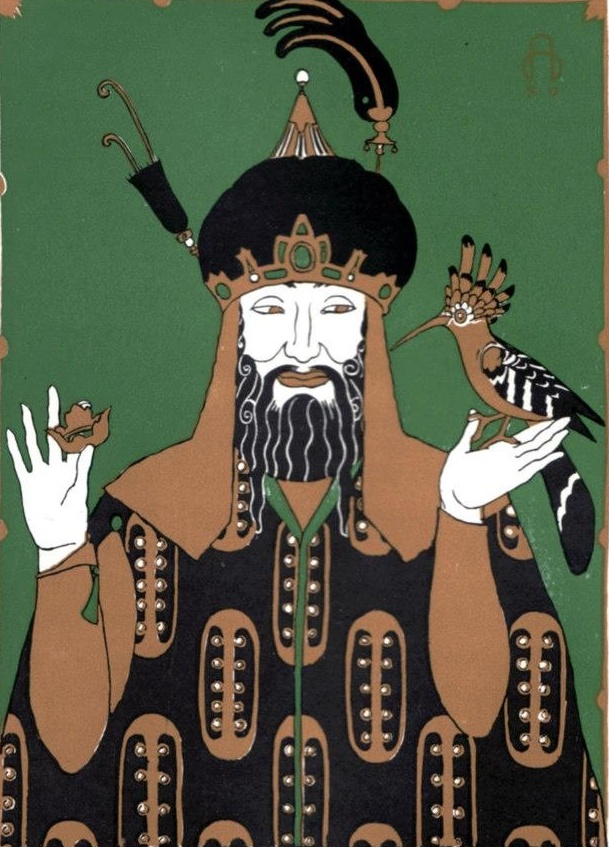In many literary works, animal and human communication is described as realistic and fully interactive in which an animal speaks to a human and the human replies back to the animal, forming a conversation. However, in our contemporary time, an interactive conversation between humans and animals has not been recorded yet. Still, there are stories of this type of interaction mentioned in a book that is believed by a large population of the world.
In Surat Al Naml in the Quran, one man was given by God the ability to understand the language of animals. This man was named Solomon the son of David, or, as known in the Bible, King Solomon. The story starts when Solomon said:
‘O you people! we have been taught the speech of Birds, and on us has been bestowed (a little) of all things: this is indeed Grace manifest (from Allah.)’ And before Solomon were marshalled his hosts, – of Jinns and men and birds, and they were all kept in order and ranks. At length, when they came to a (lowly) valley of ants, one of the ants said: ‘O you ants, get into your habitations, lest Solomon and his hosts crush you (under foot) without knowing it’. So he smiled, amused at her speech; and he said: ‘O my Lord! so order me that I may be grateful for Your favors, which You have bestowed on me and on my parents, and that I may work the righteousness that will please You: and admit me, by Your Grace, to the ranks of Your Righteous Servants’.1

This incident is considered to be true by the believers of the Quran, as the words of God, and for that reason, it deserves to receive some thoughts and contemplation. My role in this article is to bring contemporary scientific research to provide an understanding of the gift that was bestowed to Solomon by God, and answer the question if it is possible for us in this time to acquire Solomon’s gift to speak to nonhumans. To do that, I will analyze two Quranic stories – one that occurred between Solomon and an ant, and another that occurred between Solomon and a hoopoe bird – and provide some suggestions that can direct us to improve our level of communication with animals and have more interactive communication with them.
Without a chain of command or central control, ants are known to be one of the most organized organisms. How do they coordinate all the movement in their colonies? In other words, how do they communicate? Ants communicate physically by releasing chemicals known as hydrogen-carbons (H-C) that direct and specify the type of activity a group of ants should do. These chemicals take the place of what we humans refer to as a language. Each ant colony has a distinctive H-C odor that indicates which duty is assigned to which ant. They communicate through sensing the chemicals that other ants release to indicate an action.2
For humans, we understand each other through established verbal communication.3 Even though our dominant method of communication is verbal, sometimes we tend to use chemical communication in our daily activities. For instance, a mother and a baby: a mother reacts to the smell of the baby’s dirty diaper indicating that the baby needs a diaper change. The baby does not indicate that she needs a diaper change through verbally stating that. However, she releases an odor that is known to the mother, indicating the action she should take.
So, how did Solomon understand what the ant said?
According to Bihar Al-Anwaar, which is a collection of Islamic narrations, Solomon heard the ants through the wind.4 This is because God “subjected the wind to his power, to flow gently to his order, whithersoever he willed.”5 How was that possible?
This was possible because wind carries odor from broad areas to the nose. Thus, Solomon had the ability to direct the wind in order to serve a certain function. Solomon directed the wind to convey the ant’s message. Therefore, when he understood their message, he smiled and thanked God for his blessing for giving him the ability to utilize the wind and understand the ant. However, this is not the only blessing that Solomon received; he was also able to communicate with birds.
From the verse referenced above, we can recognize that Solomon had been given the ability to communicate with birds. There is another incident in Surat Al Naml that specifically mentions a dialogue between Solomon and the hoopoe bird. The dialogue starts when Solomon said:
‘Why do I not see the hoopoe? Or is he among the absentees? I will punish him most severely, or slay him, unless he gives me a valid excuse.’ But he did not stay for long. He said, ‘I have learnt something you did not know. I have come to you from Sheba, with reliable information. I found a woman ruling over them, and she was given of everything, and she has a magnificent throne. I found her and her people worshiping the sun, instead of God. Satan made their conduct appear good to them, and diverted them from the path, so they are not guided. If only they would worship God, who brings to light the mysteries of the heavens and the earth, and knows what you conceal and what you reveal. God—There is no god but He, the Lord of the Sublime Throne.’ He said, ‘We will see, whether you have spoken the truth, or whether you are a liar.’6
To communicate, birds use a blend of vocal signaling codes and body language with each other for different reasons, such as when there is danger around, mating, fighting, migrating, and eating.7 They can identify the type of danger, the distance of the danger, and how urgent it is through different acoustic features, such as pitch, loudness, and tone.8 Some of the birds have different accents that differentiate the location and the type of bird they are.

Their body language consists of different movements and poses, such as moving their tails, their wings, or their body from one side to another, even jumping. All these are examples of how birds communicate to express different meanings.9
There are two ways to understand how Solomon communicated with the hoopoe: either he was able to understand birds’ vocal signals and body movement, or these signals were converted for him into a form of human speech. To believe in the first possibility, it means that Solomon himself was able to vocalize these signals to communicate back with birds. On the other hand, if we take the second option, it means that there was a medium that Solomon had that could convert birds’ sound to Solomon’s language.
The question is, in our contemporary time, can I or any other human communicate with animals and birds like King Solomon?
After displaying different methods of communication exhibited in different animals, we realize that animals do communicate. However, they communicate differently than how humans do. If we were looking to speak to animals as we see in many animation movies, such as in Bugs Bunny, where the animal character in the cartoon has a fully interactive conversation with humans, this method of communication is probably not feasible.

However, there are ways to help us understand animals and communicate with them like King Solomon. First, we as humans will have to invest more time interacting with animals, understand their method of communication, and understand what each signal means. After doing that, we can register these signals to develop dictionaries of animal signals, where animals’ messages can be understood and learned. To develop an animal dictionary, we do not have to start from scratch. This is because some scientists have already developed that.
The Elephant Dictionary is a project that is the result of 19 years of continuous work of scientific observations on elephant communication by biologist Andrea Turkalo. The project’s idea is to record elephant sounds and link them with a behavior that is associated with the sound. Elephants use infrasonic communication, which is below what humans can hear. However, with the help of acoustic recorders that can record infrasonic sound waves, this process has become possible.10
Another step that can bring us closer to understanding animals is to develop devices that can convert specific animal sounds, odors, gestures, etc. to human speech. If it is possible for us as humans to have a device that can convert different human languages to another human language, we should be able to do that with animals. It should be possible for us to create the technology to decipher animal communication. This idea is not too farfetched; some scientists and hunters have already developed devices that can manipulate animals to do certain behaviors.

A duck call is a device that is used by hunters to manipulate ducks’ movements. The hunters use the whistle-like device by blowing to produce different sounds that ducks would use to communicate different functions. Different examples of calls like the greeting call, the feed call, the comeback call, or the pleading call are used to influence ducks’ movement.11 To have the proper reaction, the hunter has to consider the distance and the altitude of the duck, the repetition of the call, and the accuracy of the imitation. For some professional hunters, the device is an unneeded tool. This because they have the patience and the ability to effectively mimic duck sounds and guide them to their net.12 Hunters are not the only one who have created animal communication devices; marine biologists also have their fair share.
CHAT, or Cetacean Hearing and Telemetry, is a device created by marine biologist Denise Herzing that is “strapped to a diver’s chest. Once submerged, the computer detects and differentiates dolphin sounds, including the ultrasonic ones we cannot hear, and tells the diver which particular dolphin made a certain call.”13 The device is also capable of creating dolphin-like sounds that can establish a new way of communication between dolphins and humans, if the dolphins start using these sounds in their daily activities. The device relies on the idea of dolphins’ mimicking abilities to add these sounds issued by the device to their daily activities, which will allow scientists to establish an identifiable shared signal between dolphins and humans.14
Animal communication is a very sophisticated subject with many variables and variations. However, if we directed our interest more toward nature, and if we invested more time observing and analyzing animal activities, progress in this area would be feasible. In the meantime, maybe we cannot be like King Solomon. However, with more research and technological advances waiting for us in the future, we might be able to develop more tools and devices that will help us understand animal communication, either vocal, behavioral, or chemical. As of today, there have been a number of hunters and researchers who have developed devices such as CHAT, duck call, and the Elephant Dictionary that have added progress to how humans communicate with animals. This progress should serve as a beacon of hope that one day maybe we can be like King Solomon.
I would like to thank Dr. Meghann Peace for giving me the opportunity to publish my first article. Also, I would like to thank her for her continued support, patience, and expedient responses during this journey. Also, I would like to thank my mother for her prayers to God to bless me and give me the highest rewards. Last but not least, I would like to thank my wonderful wife for her patience and continued support during the hours I spent writing and researching for this article.
- The Quran (A. Y. Ali, Trans.). (2003). Credo Reference. ↵
- Laird, N., Angelides, S., Grupper, J., & Hoppe, B. (2016). Evolve: communication. The evolution of animal communication. YouTube. https://www.youtube.com/watch?v=EgMoxIPgqhA&t=89s ↵
- Pinker, S. (2007). The language instinct: How the mind creates language. Harper Perennial Modern Classics. ↵
- Al Majlisi, S. M. B. (n.d.). Bihar Al-Anwaar. https://hubeali.com/books/English-Books/BiharAlAnwaar/BiharAlAnwaar_V14.pdf ↵
- The Quran (A. Y. Ali, Trans.). (2003). Credo Reference. ↵
- The Quran (A. Y. Ali, Trans.). (2003). Credo Reference. ↵
- Ackerman, J. (2020). The bird way: A new look at how birds talk, work, play, parent, and think. Penguin Books. ↵
- Characteristics of a sound wave (n.d.). Siyavula. https://intl.siyavula.com/read/science/grade-10/sound/10-sound-03 ↵
- Ackerman, J. (2020). The bird way: A new look at how birds talk, work, play, parent, and think. Penguin Books. ↵
- Elephant Listening Project. (2018). Learning what elephants are saying. The Cornell Lab. https://elephantlisteningproject.org/eletalk/ ↵
- Ducks Unlimited. (n.d.). 8 calls every duck hunter must master. https://www.ducks.org/hunting/duck-calling/8-duck-calls-every-duck-hunter-must-master ↵
- Sawyer, R. K. (2012). A hundred years of Texas waterfowl hunting: The decoys, guides, clubs, and places, 1870s to 1970s. Texas A&M University Press. ↵
- Andrews, C. G. (2019, May 28). Will we soon be “talking” with dolphins and whales? Good Nature Travel. https://www.nathab.com/blog/will-we-soon-be-talking-with-dolphins-and-whales ↵
- Andrews, C. G. (2019, May 28). Will we soon be “talking” with dolphins and whales? Good Nature Travel. https://www.nathab.com/blog/will-we-soon-be-talking-with-dolphins-and-whales ↵



36 comments
Alina
!سبحان الله This is such a beautiful article. I am so glad to read an article inspired from one of the Islamic stories and also how you proved its scientific aspects as well. Very well written and explained. Great job Nooraldeen ??
Lynette McDuffie
Nooraldeen,
Wow what an amazing article. I love reading about bible stories so I was truly interested when you captured the story of King Solomon and the ants. I guess I never really thought about communicating with other animals or insects except my dog. As you stated, each specifies has a way of communicating. My dog wags her tail in a certain manner when she wants me to pick her up so I know. When she really has to pee or poo she scratches my leg but that’s her way of communicating what she needs me to do. She always communicates with her eyes like most dogs. When she is in trouble puts her eyes down to the ground like a child. Thank you for sharing this piece. Very well written and intriguing.
Loulou
Interesting and informative article, the way ideas are displayed and connected is so neat and thoughtful. Indeed, animal-human communication is a catchy topic that has little exposure in scientific research.
Houria
To be honest, this was a really informative story. I also really liked the words you used, they were easy to understand. I’m rlly interested in king solo and story now and I will read this again soon as my bed time story
Mohammed
The articles topic is intriguing. Anyone would enjoy reading about this article. I bet , true animals lovers would appreciate it even more. It was a great academic piece. Very professional and more important, informative. After reading this article, i feel unique by knowing animals signs codes,and gestures. It stirred my thoughts about horses (my favorite animal). Now i realized why all horses riders(that i met)make the same noise for the horse to start moving. Excellent job Nooraldeen! Keep doing what you’re doing and evolve.
Sara Gutierrez
I really appreciate how you integrated science, religion and linguistics together. Very fascinating the story of King Salomon in Islam. Your article is unique, a mind feeder. As a Biologist and animal lover I would love to read more articles like yours. Keep writing articles like this, very interesting, full of creativeness and knowledge. ?
Lynette McDuffie
I definitely agree Sara. The integration of different aspects of life as we know it was beautifully captured.
Hager
This article give me a lot of new information about Animal Communication. Specially about (Ants Communicate). It’s help me to understand the Holy Quran and gave me contemplation of Allah’s creation. Let’s say it’s the best article that I read about Animal Communication.
Thank you.
Hussain jihad jawad
Wow what a great article it was very neat and interesting.Your use if words is very nice and you grab the readers attention by telling a story.I learned a lot from it.Keep up the good work.
Sawsan
Although I got to learn a lot of historical and scientific information from that article but I enjoy reading it as fairytale. The way you write is enjoyable and give you the urge to look around to discover what’s hidden in this universe.Communicating with animals is our childhood dream which we were taught it’s impossible to happen. You put a candle here with proves that what was considered to be miraculous action can be realized to anyone if he contemplates and believes. Thank you Noor Aldeen Al Drees !
Khatoon Taher
This article is the one I liked the most, not because the author is my son but because he devoted all his time to writing a special article related to human-animal communication, he thinks it is worth it, so he cares about choosing. Specific words, beautiful pictures and distinctive phrases, in fact, I am sure that anyone who does what he did will succeed and deserve respect and be pleased with him, in addition to that my son discussed new ideas and linked religion to them and called us to contemplate what’s the inspiration that was given to the Prophet Solomon then he referred to The contemporary scientists and their efforts.Praise be to God and thank you my son for this wonderful useful work and we look forward to more.
Lubna
This was such a meticulously well written article!. I used to think talking to animals was some impossible magical power, until i read this, I understood the scientific basis, and that it was, in fact, very possible to communicate with animals. Thank you for your efforts, i can tell a lot of thought was put into writing this.